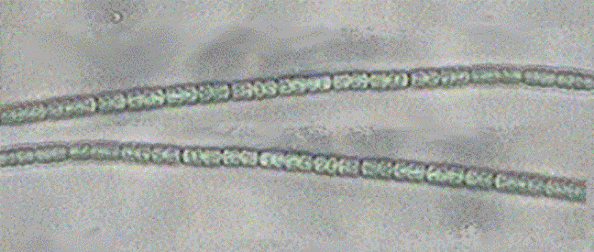
Reproduction
Anabaena have a very distinct life history compared to many
of the other forms of blue-green algae. First, they are colonial
organisms.
 The long chains of Anabaena cells are known as
trichomes. These trichomes consist of long unbranched chains of
vegetative cells, with heterocysts and akinetes spaced throughout the
chain.
The long chains of Anabaena cells are known as
trichomes. These trichomes consist of long unbranched chains of
vegetative cells, with heterocysts and akinetes spaced throughout the
chain.
While Anabaena is an algae, it is slightly motile through a gliding
type movement, which is also a way to separate it from a close relative,
Nostoc. It is thought that this movement is caused by waves of
propulsion across the entire trichome! Also, it is believed that a
slime secretion is used to aid in movement. 
Anabaena typically reproduce via fragmentation. Fragmentation is where a section of the chain will split off and either float or glide away. After a while these sections begin to form their own chains. These sections are known as hormogonia, and arise via the separation of adjacent cell walls. They are also caused by dead cells that become separation discs.
 Anabaena is not just a free living organism, it also has many
symbiotic relationships with other organisms! To learn more about these
relationships, lets head over to the
interactions page.
Anabaena is not just a free living organism, it also has many
symbiotic relationships with other organisms! To learn more about these
relationships, lets head over to the
interactions page.
You can also look at other aspects of Anabaena by going back to the home page.